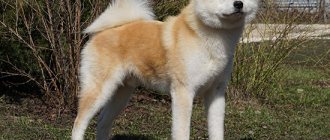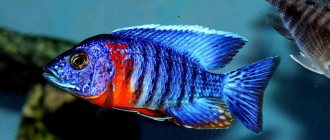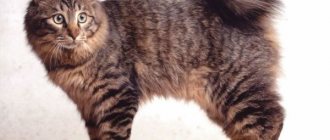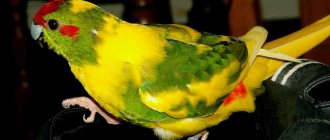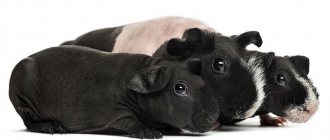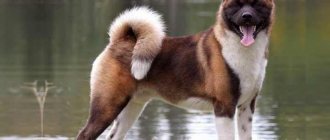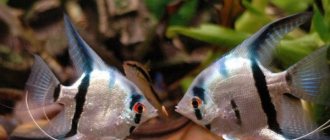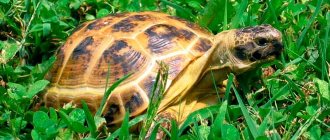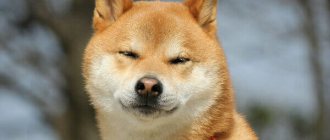What a pet eats determines its appearance, physical development, activity, health, and, ultimately, life expectancy. It is necessary to choose the most suitable diet for an Akita pet and at the same time take into account the breed characteristics of these dogs.
Natural food and artificial feed
Dogs of this breed may not tolerate chicken meat, as well as beef and pork, or even refuse to eat them. The reason is that over the centuries of their existence, Akitas have become accustomed to eating mainly fish and seafood, including algae. Their body digests light protein foods better than red meat. Feeding your Akita natural food can be expensive and quite time-consuming.
Most breeders prefer feeding their pets with high-quality industrial food.
If the dog eats “natural” food, then it is better if the basis of its diet is sea fish and seafood.
Which feeding method is suitable for an Akita Inu?
Like dog owners of other breeds, Akita owners have a choice:
- feed the dog industrial food;
- switch to 100% natural food;
- use the mixed nutrition method.
It must be said that for most breeds the latter option is not welcome. But for Akita Itu, feeding with food and natural food is the most optimal. You can alternate dry food with meat, dairy products, cottage cheese, vegetables and fruits.
Naturally, you should take into account various nuances so as not to harm your pet. Thoroughbred representatives are predisposed to obesity, so you need to monitor their physical shape.
Akitas have one peculiarity - with a lack of physical activity, dogs can voluntarily refuse food and can starve for up to three days. This phenomenon is rare, but still occurs. In this case, you do not need to take any action.
Positive and negative qualities of a “straight girl”
Natural nutrition has both advantages and disadvantages. Before making a choice in its favor, you need to carefully calculate how appropriate it is for you to feed your dog home-cooked food.
pros
- The owner chooses the products himself and can control their quality.
- Home-cooked food does not contain stabilizers, dyes or other harmful food additives.
- The owner of an Akita can change the pet’s diet based on the dog’s personal preferences, the state of its health and its capabilities.
- When feeding homemade food, the dog receives natural nutrients and trace elements.
Minuses
- The owner of an Akita must prepare a diet for his pet, taking into account its balance.
- Preparing homemade food takes a lot of time.
- A balanced natural diet will be more expensive than feeding high-quality ready-made food.
- Natural products can cause allergies in your pet.
- When feeding your Akita with homemade food, you will have to add vitamin and mineral supplements to the food.
History of the Akita Inu breed
These dogs have been known since ancient times.
The ancestors of modern Akita Inu lived two thousand years before our era. The breed was first mentioned at the beginning of the 17th century in Japanese treatises. Unique dogs were bred in Japan. Having received a luxurious pet, the inhabitants of the Land of the Rising Sun did not really think about what name to give it. They decided to name the animal in honor of the province of the island of Honshu, where the first representative of the breed, the Akita, appeared. Well, ino means “dog” in Japanese.
Akita Inu is one of the few dog breeds in the world whose genetic makeup has not changed for several centuries. The only changes were in the way pets were used.
Until the 18th century, dogs played the role of selfless guards of the homes of common people. Then their owners were not particularly interested in the question of what to feed the Akita Inu. The animals ate mainly scraps from their owners' tables.
Some time later, the dogs were noted by the nobility for their magnificent appearance and innate grace. As a result, the Akita Inu was classified as an elite class, and from then on its calling became to please members of the imperial family and close aristocrats.
In 1927, a special society was created whose responsibilities were to preserve the purity of the breed.
Today, Akita Inu have become popular all over the world thanks to the feature film directed by Lasse Hallström “Hachiko: The Most Faithful Friend”. The film, based on a real story, told about the main character trait of a dog - devotion to its owner until its last days.
List of permitted and prohibited products
An adult dog can be fed the following foods:
- Boneless fish (sea and pre-frozen), seafood, as well as seaweed.
- Meat products: lamb, veal, horse meat, turkey or rabbit meat, as well as offal (preferably liver or heart scalded with boiling water).
- Porridge: rice, buckwheat or millet.
- Raw or boiled vegetables: carrots, pumpkin, zucchini.
- Fruits: apple, pear, banana, melon, if you are not allergic, then you can also have berries.
- Dairy products: cottage cheese, natural yogurt, kefir or yogurt.
Diet features
Smart and beautiful dogs are very popular not only in Japan, but also in Europe. Many people love them for their loyalty, good manners, intelligence and external grace. Playful as children and reserved as adults, they are always happy to have an owner and play with children. Well-mannered, neat, affectionate and loving dogs will always protect the owner and their family, and their devotion is the highest level of loyalty: you can see this by watching the film “Hachiko”.
Raising such a friend is not easy; he needs attention, affection, love and friendship. It is proper education, care and a balanced diet that will make your pet truly beautiful and happy.
The origin of the breed took place in Japan, and it is there that a large number of animals are concentrated. Brought up in the traditions of the samurai, dogs are accustomed to their regime and diet, which means they need to be fed accordingly.
Basic diet:
When purchasing a dog, first of all, read this list, because your four-legged friend may be allergic to common foods.
Gallery: Akita Inu puppies (25 photos)
List of prohibited products
While other dog breeds like to eat chicken, turkey or beef, for the Akita Inu the food is selected individually and the diet is strictly followed. You shouldn’t take risks and accustom your dog to foods that are familiar to us; this can negatively affect its health and cause an allergic reaction.
- Sweet and salty foods;
- Confectionery (sugar, candy, cookies, cakes, etc.) - increased blood sugar can cause diabetes;
- River fish - it has a lot of small bones;
- Smoked meats and fatty foods;
- Sausage and deli meats;
- Meat (pork, beef, poultry - chicken, duck, goose, turkey);
- Corn, wheat, oatmeal;
- Milk and fatty dairy products.
Try to avoid the listed ingredients in your diet and your pet will be healthy and happy. The treat will be replaced by a piece of boiled sea fish or boiled eggs.
Industrial
Feeding with industrial feed (dry and wet) also has both advantages and disadvantages.
Advantages
- There is no need to waste time preparing food for your dog.
- There is no need to add vitamin and mineral supplements to your pet's food.
- There is no risk of parasite infection.
- Ready-made food will cost less than natural food.
Minuses
- Ready-made food may contain harmful chemical additives.
- If for some reason you can’t get your pet’s usual brand of food, problems may arise when trying to feed him another food.
Which food do you prefer: dry or wet? Wet is softer in structure, does not cause thirst in the animal, and moreover, it contains less “chemicals”. However, dry food is more convenient to take with you on the road, and it does not stain dishes or the dog’s fur. When choosing food for a dog of this breed, you can use the following rating, based on reviews of Akita owners and breeders:
- Purina Pro Plan.
- Acana.
- Artemis.
- Belcando.
- Canidae
- BioMill.
- Almo Nature.
- Royal Canin.
This rating includes food of at least premium class, since budget-class diets are not suitable for Akita.
The most suitable food for Akitas is rice-based food with the addition of salmon or tuna.
Industrial feeds - pros and cons, dry or wet, manufacturers
Dry and wet food have their own advantages. Many Akita Inu owners argue among themselves which is best to choose. The following advantages have been identified in canned food:
- more fluid, which is why the dog will not be thirsty;
- they do not harm tooth enamel;
- Canned food is made in packages designed for one meal or a day, and therefore the risk of overfeeding is eliminated.
However, each owner must decide for himself what to feed his pet.
Super premium canned food
Features of feeding dry food
In industrial feeds, manufacturers took care of the balance of food, and therefore there is no need to worry about it again. This also makes it quicker and easier to dose your dog's food. However, there are also certain disadvantages of ready-made food: most brands are not suitable for feeding Akita Inu, since they contain soy. The animal’s body is not adapted to absorb it, and therefore the pet may develop an allergy.
Note! The dog will be provided with everything necessary if the food contains natural ingredients such as fish, meat and bone meal.
The main advantages of ready-made food for Akita
Among the advantages of ready-made food it is worth highlighting:
- balance;
- availability;
- diversity;
- ease of feeding;
- the presence of hypoallergenic species.
You can buy products at pet stores. At the same time, you should consider only premium options.
How to choose the right food
When choosing food for your Akita yourself, you need to pay attention to premium and super-premium products. They can be purchased in specialized stores. It is also necessary to study all the symbols on the packaging. If it has the inscription “natural” on it, this indicates the naturalness of the products from which the food is made. If the designation “holistic” is present, then this is an excellent option for feeding allergy sufferers. When indicating “human-grade”, the composition must contain components suitable for human nutrition. All three options are suitable for feeding Akita.
Food for sterilized dogs – TOP best 2020
Every year new brands of food appear on the market, which are selected depending on the characteristics of various breeds. Many are universal and contain a sufficient amount of useful elements so that you do not have to feed them with additional vitamins. The most popular in 2021 are:
- Akana. Premium class. Contains 40% chicken and beef, 4% chicken eggs. Additionally, it contains magnesium and phosphorus, legumes, vegetables and fruits.
- Eukanuba. Its granules contain lamb, salmon, chicken, and turkey. All this variety is seasoned with rice.
- Canide is the most expensive food intended for feeding allergy sufferers. Made from high quality turkey, chicken and lamb meat. Contains a large amount of vitamins and minerals.
- Farmina. An optimally balanced diet that contains components for burning fat, in addition to chicken eggs and meat.
Important! When purchasing industrial feed, carefully study the composition. Most popular brands, such as Pedigree, Royal Canin, often contain soy, a very strong allergen.
Feeding the puppy
In the first days after purchasing puppies, it is recommended to feed them what they are used to eating in the breeder’s home. Later, you can gradually transfer the baby to another diet that is more convenient for the owner.
Up to two months
Puppies are fed six times a day. The daily diet necessarily includes meat or fish, which are fed to the pet at 100 or 200 grams per day, cottage cheese (up to 150 grams per day), as well as milk, kefir or low-fat yogurt, vegetables and cereals - all 100 grams per day.
At two
The number of feedings is 5-6 times a day, while the rate of feeding meat or fish increases to 200-300 grams, cottage cheese, as well as milk or fermented milk products - up to 200 grams. The share of vegetables in the diet can also be increased slightly, to approximately 150 grams.
Three
The puppy is fed 4-5 times a day. His diet must include 300-350 grams of meat or fish, as well as up to 200 grams of cottage cheese, dairy products and vegetables. The proportion of porridge also increases and now amounts to 150 grams.
Four and five
By this age they switch to three or four meals a day. The amount of fish or meat products reaches 400 grams, cottage cheese and vegetables - 250, and porridge up to 200 grams.
By the age of four months, milk should be eliminated from the diet and replaced with kefir or natural yogurt.
After six months
The puppy is transferred to three meals a day. At this time, the amount of meat or fish in his diet increases to 500 grams, cottage cheese to 300, vegetables to 250, and porridge to 200 grams.
Recommendations for feeding Akita Inu with natural food
Do not forget that Akita Inu is a breed of dog that originated in Japan, where gastronomic habits and traditions are completely different. They have a very delicate stomach that does not accept heavy and fatty foods, and therefore you cannot feed them anything, since they will not even take these foods on their tongue.
Akita Inu is picky about food
Natural diet
You should not experiment with your Akita Inu's food, often including new foods. It is preferable to use time-tested recipes. It is recommended to give your pet more vegetables. Sometimes animals can be fed with raw eggplants, carrots, pumpkins, onions and zucchini, but it is still recommended to boil them.
You should start giving fruits no earlier than 4 months of age. It is better to choose green apples, bananas, melon and pears. It is worth giving up grapes, as they cause fermentation in the intestines, and blackberries. Many pets love persimmon, but you shouldn’t give it often because it acts as a laxative.
List of allowed and prohibited foods for Akita Inu
Adult dogs should eat twice a day. Their diet must include fermented milk products, unsalted cheeses, boiled eggs, and meat. This breed feeds well on wild meat.
There are a number of foods that are prohibited from feeding an Akita Inu (as this can lead to a number of diseases), including:
- tubular bones;
- freshwater fish;
- fatty dairy products;
- lean meat;
- sausages and smoked products;
- spicy, salty, pickled food;
- wheat, corn, oats, legumes;
- sweets and sweet products.
Important! Sweet foods are especially harmful for Akita Inu, since this breed often develops diabetes.
How to feed natural food
Fish should be given at least a couple of times a week, even if the dog doesn’t really like it. It is better to use low-fat sea fish, which after freezing can either be boiled or doused with boiling water. The bones must be removed yourself.
The portion is calculated so that there is twice as much fish as usual meat. You can grind the fish in a blender along with the bones, as they are a source of calcium. It is permissible to boil bulls - this is a fairly cheap option for feeding the American Akita, but no less beloved by the animal.
From porridges you should choose buckwheat, rice and millet. At the same time, do not forget to season them with vegetable oil: you can use flaxseed, corn, sunflower and olive.
Rice porridge in a cup is an essential component of a dog’s diet.
Pros and cons of natural food
The main disadvantage of natural nutrition is the need to select a nutritional supplement for the dog, which causes certain difficulties for inexperienced Akita Inu owners. However, there are a number of advantages to this:
- the dog does not show whims regarding the monotony of food, since the owner offers a variety of types of food;
- the owner is firmly confident in the quality of the food and the freshness of its ingredients;
- natural nutrition is as close to natural food as possible.
It is worth knowing that your pet may not receive enough nutrients from such products, and therefore he will need to be given vitamin and mineral complexes.
Is it possible to give a dog chicken bones and offal (liver, heart, stomach) without harming its health?
Of the by-products, it is recommended to give preference to nutritious ones, such as liver, heart, kidneys and lungs. In order for your pet to feel good after eating such food, it is worth boiling them for a long time. But you should not let your Akita try pork offal, since their stomach will not be able to digest such fatty food.
Food for an adult dog
An adult Akita is fed twice a day - in the morning and in the evening. During the day, you can give your pet additional treats during training sessions, but in this case you will need to slightly reduce the portion during the next feeding. The total daily food intake with natural feeding is approximately 2-3% of the total weight of the animal. In total, the Akita’s diet should include the following foods:
- Meat, fish or offal - from 500 to 600 grams.
- Porridge (rice, buckwheat or millet) - from 200 to 250 grams.
- Vegetables (raw or boiled) - chopped, approximately 250 grams.
- Kefir, curdled milk or natural yogurt - approximately 150 ml.
- Cottage cheese - 200 grams.
- Boiled egg - 1 yolk once a week.
If the animal eats ready-made food, it should be selected in accordance with the dog’s health and physical activity.
For animals suffering from allergies or other diseases that require special diets, special dietary foods are suitable.
Basics of care
To maintain the beauty of your coat, give it time once a week. But remember the big drawback of the breed - heavy shedding 2 times a year, which lasts about 2 weeks. At such moments, daily care is required. Living in a cold climate and keeping your dog indoors can moderate shedding slightly. With proper care, your pet will have a medium smooth coat and a very soft undercoat. You should not bathe your dog often. The fact is that Akita Inu wool has waterproofing properties, which you risk depriving your pet of.
Once a month, wipe your eyes with chamomile decoction to prevent souring. Redness, swollen eyelids or excessive watery eyes can be not only a symptom of a common allergy, but also a more dangerous disease. Don't hesitate and contact your veterinarian.
The claws should be trimmed and smoothed with a nail file at the same frequency. But it is important to wipe the auricle once a week. Healthy ears are always pink in color, without foreign odors.
Pay attention to your teeth several times a week. Remember that cleaning should be done with a special paste for animals. The usual human paste will be harmful to the stomach.
Don't forget about routine vaccinations and preventive examinations at the veterinarian! Then you will be confident in the health and well-being of your pet, because your pet cannot complain and show where it hurts.
Mixed diet
Most dogs of other breeds do not tolerate a mixed diet well, but an Akita can alternate between home-cooked food and commercially prepared food. This food option for representatives of this breed is considered quite acceptable if it suits the owner of the dog and the dog itself. However, it should be remembered that mixed nutrition does not mean feeding natural products and ready-made food at one time, as this is fraught with serious problems with the pet’s health.
How to organize your diet
Akita Inu requires more careful care than four-legged dogs of other breeds. In particular, this applies to animal nutrition.
According to the recommendations of veterinarians, Akita owners can choose one of the following feeding options for their pet:
- food of natural origin (raw or home-cooked);
- ready-made food of industrial type (dry or wet);
- mixed nutrition.
It is the third type - mixed nutrition - that is considered the best option for this breed of dog. Dry food should be alternated with meat and meat by-products, cottage cheese and fermented milk products, fruits and vegetables. The daily diet should be balanced, control the amount of carbohydrates, fats and proteins.
Also, do not forget that this breed of dog came to our region from Japan, where traditions and habits are different, including in gastronomic terms. The delicate stomach of Asian dogs often cannot cope with the food that other four-legged dogs are accustomed to. At the same time, Akita Inu requires special care and maintenance. Be sure to keep food and water bowls clean. If the size of the booth where the pet lives allows, try to separate the dog’s “dining room” from the resting area.
How to feed natural food
Feeding a dog of an exotic breed with natural food is not an easy task. Indeed, in their native country, the Akita Inu diet consists mainly of rice, fish, seafood, fruits and vegetables. An adult dog needs to be fed twice a day - morning and evening meals. Don't know what products should be on the menu?
Related article: How to choose and name an Akita Inu puppy
The diet can include:
- sea fish;
- meat of wild animals (venison, elk, roe deer meat);
- meat by-products (kidneys, liver, lungs, heart);
- fermented milk products (cottage cheese, kefir, yogurt, natural yogurt);
- hard cheese (unsalted varieties);
- porridge from rice, buckwheat and wheat cereals;
- vegetables (pumpkin, zucchini, carrots, eggplants, onions);
- fruits (apples, pears, melon, banana, persimmons in limited quantities, almost all berries);
- vegetable oil (olive, flaxseed, sunflower).
Features of feeding dry food
Often, owners of dogs of exotic breeds, wanting to make their lives easier, give preference to ready-made industrial food. However, not all dry food is suitable for Akita Inu. So, how to choose dry food for your Akita Inu?
Rule #1
Carefully study the component composition. If soy is present among the ingredients, you can immediately exclude this product from your list. Foods high in soy are not suitable for Asian breed dogs. A large amount of protein can provoke an allergic reaction in a pet.
Wheat and corn are two other ingredients that should not be in exotic breed dog foods. These two products will not cause any particular harm to the health of the animal, but can negatively affect the functioning of the gastrointestinal tract and the general well-being of a dog that is not accustomed to this type of food. Choose dry food that contains fish, meat, rice and bone meal.
Rule #2
Pay attention to those foods that indicate the daily requirement according to the weight and age of the animal, because an adult dog and a small puppy need different amounts of fats, proteins and carbohydrates. For example, the daily fat intake for puppies should not exceed 18%, while babies need at least 25% protein.
Rule #3
Give preference to premium and super premium food. If you can’t find food on your own, you can always seek help from a veterinarian or more experienced dog breeders. They will certainly tell you how to care for a four-legged Asian breed.
Related article: Main differences between Shiba Inu and Akita Inu
What you should absolutely not feed
If you still couldn’t resist the charisma of dogs of this breed, get ready for some difficulties in caring for and maintaining a pet.
Feeding Akita Inu differs significantly from feeding other dog breeds. One slight mistake in feeding can lead to serious health problems for your pet. To avoid such troubles, it is recommended to familiarize yourself in advance with the list of foods that should not be present in the diet of this breed.
So, what food should you not give your Akita Inu?
- foods high in salt;
- food products with various food additives or “food chemistry”;
- sausages;
- smoked and pickled foods;
- river fish (as it contains a lot of small bones);
- raw meat and raw fish (to prevent helminths from entering the animal’s body);
- all sugar-containing foods (this breed has a hereditary predisposition to diabetes).
Regardless of whether you feed your dog dry food or homemade natural food, do not leave food in the dog's bowl. Airing, drying out, getting dust, debris and insects into the bowl, which is especially typical for animals living outside in a kennel, can negatively affect the health and well-being of the pet. Also, do not forget to keep your Akita Inu's kennel clean.
It is especially important not to miss this moment during the animal’s molting period. A shedding dog requires more attention and care. The Akita sheds, the fur gathers in clumps, settles somewhere in the corner of the dog house and, at the slightest breath of wind, ends up in the food. Representatives of this breed are willful and have a good memory.
Having once fed your dog something forbidden, in the future you may encounter aggression or, conversely, excessive attention from a pet begging for another “delicacy.” As experienced dog handlers note, prohibited foods can negatively affect the dog’s gastrointestinal tract and also cause allergies. Frequent health problems negatively affect the dog’s psyche; the animal begins to be wary of any new food product.
Similar article: History of origin and characteristics of the Akita Inu breed
During pregnancy and after childbirth
During the first month of pregnancy, you cannot dramatically change your pet’s diet or, especially, increase the portion size. Some bitches may be predisposed to toxicosis, which is why they often refuse food. There is no need to force your pet to eat when she has no appetite. But you can offer her her favorite food, which she usually does not refuse.
Starting from the second month of pregnancy, it is necessary to gradually increase the amount of protein foods in the bitch’s diet. If the Akita was fed a branded food before pregnancy, it is recommended to switch it to a ready-made diet intended for pregnant dogs or the smallest puppies. The number of feedings also increases: if in the first month of pregnancy the dog is fed 2 times a day, then from about the fifth or sixth week of pregnancy the number of feedings increases to three, and closer to childbirth - up to four times.
A week before the expected birth, meat is completely excluded from the bitch’s diet and replaced with boiled sea fish without bones. After whelping, the dog should be offered some light protein food to restore strength. Grated boiled meat or fish, as well as cottage cheese mixed with kefir or natural yogurt, work well.
At this time, the number of feedings is 5-6, and food is fed in small portions. In the second or third week after birth, the amount of food is doubled, and the dog is fed 4 times a day, and by 4-6 weeks the number of feedings is reduced to three.
When feeding natural food, the bitch should receive vitamin and mineral supplements from the very beginning of pregnancy.
How to feed Akita Inu: diet for puppies and adult dogs
The Akita Inu (or large Japanese dog) is one of the oldest breeds, originating more than 8,000 years ago in Japan. Strong and proud dogs guarded the territory and accompanied people on the hunt.
Today these dogs are loved not only in their homeland, but also in other countries. The famous film “Hachiko” contributed to the spread of the breed.
Akitas were raised in the spirit of samurai, which affected not only their character, but also their feeding habits.
Diet selection
One of the main characteristics of the Akita Inu is its high tendency to food allergies. Even food that is well suited to other breeds can lead to poisoning.
In Japan, Akitas have been fed a diet of fish, rice, vegetables, seaweed salads and seafood for centuries. The higher the percentage of “Japanese blood” a puppy has, the more its digestive system is focused on such a diet.
Therefore, you need to feed your Akita Inu fish, rice with vegetables and a small amount of lean meat.
Unlike other breeds, Akitas accept a mixed diet well. A combination of homemade food and industrial feed is the best option for them.
Natural nutrition
Food should be light and low in calories. Excessive amounts of fats and grains (except rice) lead to skin diseases, allergies, joint problems, and problems with the liver and pancreas. The most common cause of allergies is chicken. It's not the meat itself, but the hormones and antibiotics that are so abundant in this product.
Japanese dogs are genetically predisposed to eat fish. A large amount of meat (especially industrial meat) in their diet provokes rashes and eczema. The dog may even lose its undercoat.
You should not give sweets, otherwise your pet may develop diabetes. With a lack of physical activity, Akitas refuse to eat and starve for up to three days. There is no need to panic, such situations are rare, but they do happen.
Remember: Akitas should not be fat, because the layer of fat under the skin leads to hair loss.
Summer food should be low-fat. In hot weather, provide rice, vegetables, low-fat dairy products, a boiled egg and some meat. In winter, the amount of food can be increased.
Dogs need to be fed at the same time, this will set up the digestive system to work properly. The main feeding is best done in the morning. To clean your teeth, you can give some food in the evening.
Remember that the Akita must have access to fresh water at any time of the day.
Basic diet
Food must be of high quality and properly selected. The diet of the “large Japanese dog” includes:
- fish (sea, pre-frozen);
- boiled rice;
- seafood;
- kelp, seaweed;
- vegetables and unsweetened fruits;
- game (elk, roe deer, deer);
- lean veal;
- low-fat cottage cheese.
The American Akita can be fed meat, cereals, and vegetables. Her diet should consist of:
- beef, lamb, horse meat;
- poultry and offal;
- buckwheat, rice, oats;
- yogurt, kefir;
- boiled and raw vegetables, berries, fruits.
Remember that fish, meat and offal must be frozen first. There is no point in subjecting them to heat treatment or grinding them into minced meat.
Acceptable
Japanese Akita Inu can be given in moderation and with an eye to the reaction:
- lamb, rabbit, horse meat;
- offal (except liver and lung);
- cottage cheese;
- with caution - meat from industrial animals.
Absolutely forbidden
Digestive problems and allergies in Akitas can be caused by:
- river fish (due to the abundance of bones);
- poultry (chicken, turkey, goose);
- beef;
- sausages;
- smoked meats;
- pork and lard;
- fatty dairy products;
- corn, wheat and oats;
- confectionery;
- salty foods;
- spices;
- bones of birds and animals;
- potato;
- white bread and pasta;
- food with chemical additives.
Industrial feed
Ready-made dry and wet formulas for Akita Inu can be a simple solution to the nutritional issue. They contain everything you need, because manufacturers have already taken care of the correct ratio of all nutritional components. We are talking about formulas based on rice, salmon or tuna. Some dogs of this breed do well on food containing lamb, rabbit, duck and rice.
Only premium and super-premium mixtures, which are sold in specialized stores, are suitable for feeding Akita. If the packaging says “natural”, the food contains natural products, “holistic” - the formula is suitable for dogs with food intolerances and allergies, “human-grade” - the ingredients are suitable for human consumption. All of these mixtures are suitable for Akita Inu.
Pronature food - food for dogs of the highest quality
A good food must meet the following criteria:
- One source of protein: fish (tuna, salmon, anchovies, sardines), sometimes duck works well. Akita Inu rabbits and lambs are generally ignored. Soy is strictly prohibited.
- Protein content – 21-26%, fat – 12-18% (that is, the food must be holistic-grade).
- The source of carbohydrates is rice (the addition of potatoes, barley, oats is acceptable). Feeds containing wheat or corn are excluded.
When selecting industrial mixtures, carefully read the composition on the back of the box. If the label says “salmon and rice,” there is no guarantee that organ meats, chicken, and other grains were not actually used. Akita Inus of Japanese origin are especially sensitive to unsuitable food.
Canned food with a high protein content causes Akita Inu allergies: discharge from the eyes, from the ears, dermatitis, and digestive problems.
Since it is now difficult to find suitable holistic-class mixtures on the Russian market, Purina Pro Plan “Salmon with Rice” food can be used as an alternative. Good reviews are also given on GO! NATURAL Holistic, Acana, Pronature Holistic, Natur Line “Lamb with Rice”. The dosage is selected at the rate of 400-500 g of dry food per 30 kg of dog weight.
Mixed nutrition
In Russia, dogs are traditionally fed ready-made formulas or natural products. In Japan, it is customary to combine two methods of feeding, so Russian breeders also adhere to this diet.
The most beneficial for Akita Inu is a combination of dry industrial food, mineral and vitamin complexes and recommended natural products.
Homemade food can be replaced with canned dog food, but feeding just one thing is not recommended.
Age characteristics
The needs of a dog's body change as it grows and develops. The health and well-being of your pet depends on a properly selected diet.
Up to two months
In the first weeks after birth, the puppy feeds on mother's milk, which contains all the necessary nutrients. At this age, Akita Inu puppies need to be fed about 6 times a day: at 7:00, 10:00, 13:00, 16:00, 19:00, 22:00. If your pet came to you before the age of two months, you can use special industrial milk. Then complementary foods are gradually introduced into the diet.
At two months
At this age, small Akita Inus are usually “weaned.” Puppies can have a hard time being separated from their mother. The first two days of being in a new place they whine.
Many owners try to relieve anxiety with food, and as a result, Akitas experience the first food poisoning in their lives. To avoid this, ask the breeder in advance what kind of food the puppy ate with its parents.
On the first day, give it to him half as much as he should. Then, as your pet gets used to the new conditions, gradually increase the food to the previous volume.
Use puppy food. It can be finely crushed and dissolved in special milk for weaning. The volume should be such that the dog is full. Continue feeding 5-6 times a day at the same time. Gradually, low-fat calcined cottage cheese, sea fish, and finely chopped boiled veal are introduced into the diet. Once a week, be sure to give a boiled egg.
Proper feeding of small Akitas should include 25% protein and no more than 18% fat. Don't forget the rice porridge. For normal functioning of the stomach and intestines, add raw vegetables to the diet.
It is very convenient to use ready-made food. Natural food should only be freshly prepared and warm (not cold, not hot). If within 20 minutes the puppy has not eaten the food offered, remove the bowl and do not offer other food until the next feeding.
At three months
At this age, the dog grows very quickly. Due to increased activity, four meals a day and water consumption should correspond to the daily diet of an adult dog.
At the same time, the quality of food should change. The puppy is given more fish and meat than dairy products.
To make the food more dense, small fish is added to the soaked food, half mixed with rice porridge.
This food is more suitable for the needs of Akita Inu than market dog food. Pay attention to your pet's appetite and needs, as well as the condition of its feces, skin, fur and muscles.
At four and five months
Meals are switched to three meals a day: at 7:00, 12:00, 17:00 and 22:00. A healthy Akita puppy should not be overly thin or overweight.
Do not feed your pet; make sure that its sides do not “swell” after a meal. If the food remains in the bowl, you can reduce the portion by half until the Akita learns to eat all the food offered.
And on the contrary: if the baby licks the bowl for a long time, it means there is not enough food and it should be added.
Never give your puppy game bones, poultry, sausage, pork, ham, fatty cheeses, bread, pasta and raw river fish. Also avoid legumes, sweets, potatoes and other foods that your dog doesn’t need.
When feeding ready-made industrial formulas, your pet does not need additional mineral and vitamin complexes.
Playfulness, activity, curiosity, normal weight gain, good condition of the skin, coat, muscles and skeleton, timely appearance of baby teeth - all this indicates the normal development of the puppy.
After six months
Energy for normal development requires less and less energy, mainly the skeleton develops. Therefore, the diet should no longer be so high in calories. If you continue the same feeding regimen, your pet will quickly gain excess weight and the bones will begin to deform. It is better for the puppy to be thin.
At 7-9 months, dogs begin puberty, behavior changes, and appetite may decrease. At this time, it is important not to accustom the Akita to “tasty” food, otherwise it will be difficult to correct it later. After all, dogs of this breed are known for their stubbornness and tendency to dominate.
At the age of 6-12 months, the Akita is transferred from Pappy food (for puppies) to Junior. Gradually they begin to add adult formulas to the diet. Vegetables can be grated, meat can be cut into larger pieces. Cottage cheese and fermented milk products should only be low-fat.
Adult dogs
The diet of a mature Akita does not change significantly. Gradually the dog is transferred to two meals a day. The main amount of food should come in the morning. It happens that with low loads and a sedentary lifestyle, Akitas eat once every two days.
Old age
The first signs of a dog's impending old age are:
- graying of fur (first on the face);
- deterioration of hearing and vision;
- low activity;
- irritability.
If these signs occur, you should reduce the fat and calorie content of your diet (6-9% fat, 15-20% protein), and at the same time increase the amount of fiber to 5%. Add more pureed vegetables to your food, but not cereals.
Give your pet low-fat fermented milk products. You don’t have to cook fish and meat, but simply freeze them. There is no point in grinding them. If your older Akita has bad teeth, simply cut the fillets into smaller pieces.
For an aging dog, the “Light” and “Senior” formulas are suitable. When planning a feeding diet for an older Akita, listen to your veterinarian's recommendations.
Supplements
Dogs with Japanese ancestry must be sure to add seaweed, which contains iodine, to their food. If the Akita receives proper nutrition, it does not require additional vitamin and mineral supplements. In spring and early summer you can feed dry yeast.
Adult dogs during lactation and puppies need specialized mineral supplements. Breeders recommend Canvit Junior vitamins, as well as Polidex supplements for joints. Canina products have proven themselves well.
Reviews
Maxim, Moscow
Features of food for an old dog
In old age, the animal's activity decreases, which is why the pet can quickly gain excess weight. Therefore, you need to reduce your caloric intake. The best option would be to switch your pet to special food for older dogs. If an elderly Akita has any health problems, then a special dietary food will be suitable for her.
Before making any changes to your aging pet's diet, you should consult your veterinarian. He will help you choose the most appropriate feeding option.
Feeding
For the health of the animal, dry food is made from sea fish (tuna, salmon) and rice. Duck, lamb and rabbit will not worsen digestion. But there should be no corn in the ingredients - according to research, B vitamins are less absorbed in the Akita Inu’s gastrointestinal tract and vision loss is possible.
Take the Attention Test! Find 10 differences! (click right here!)
Find the answer Are you bothered by some problem or question? Enter “Breed” or “Name of the problem” into the form, press Enter and you will find out everything about the issue that interests you.
There should be less carbohydrates in the feed - their predominance over proteins and fats will cause a strong allergic reaction.
The American Akita Inu's stomach is not so problematic and dry food with veal is suitable for her. But the Japanese branch of the breed requires a strict diet. A purebred oriental dog will enjoy the drying of the holistic class.

